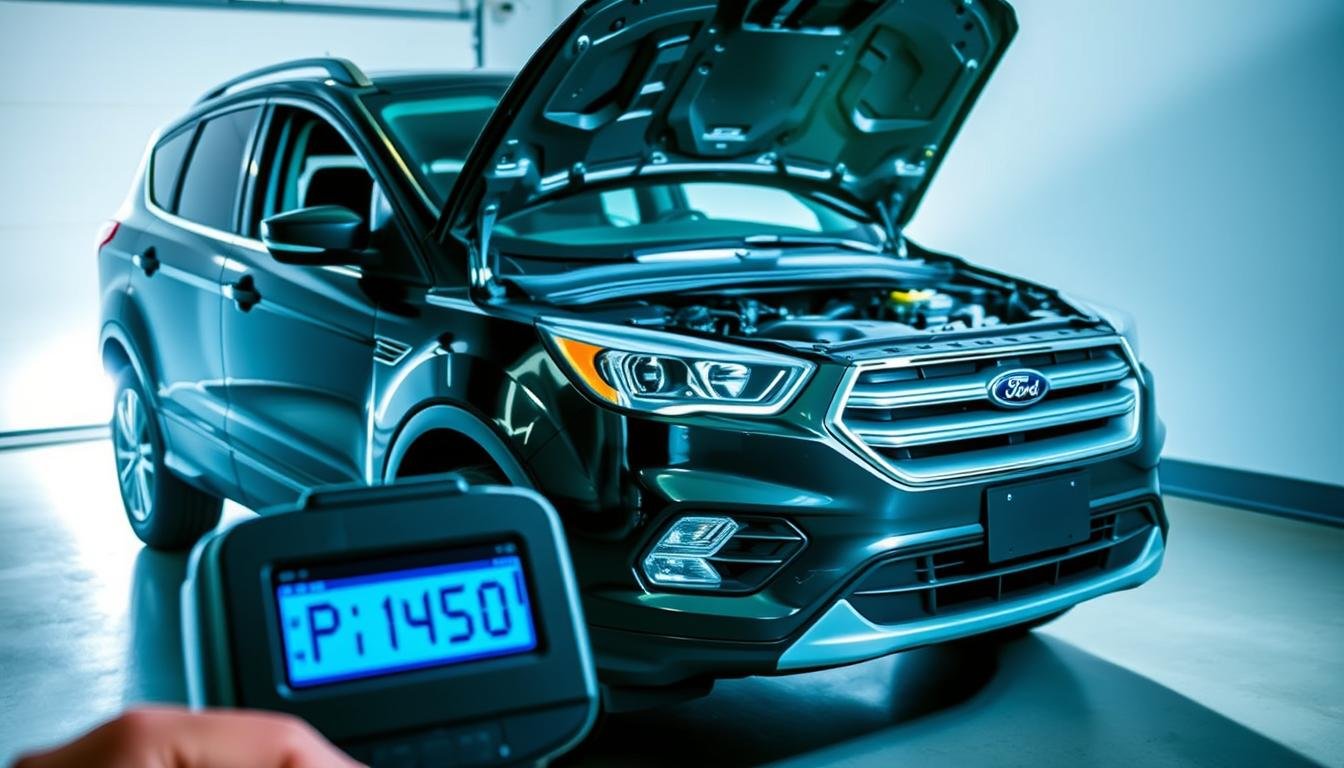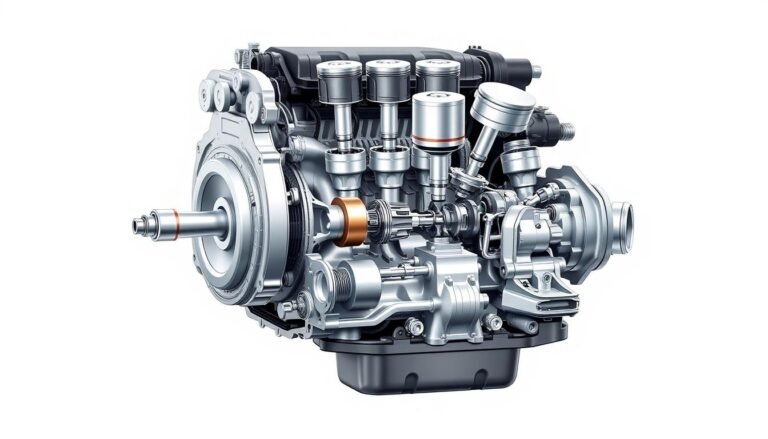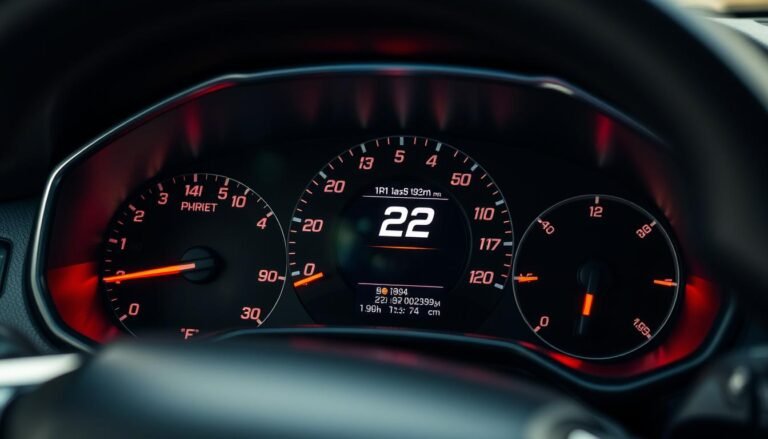Code P1450 Ford Escape – Causes & Fixes Guide
The P1450 code on a Ford Escape signals a problem with the evaporative emissions system. This system is key to lowering your car’s pollution.
Knowing about this code p1450 ford escape is important for keeping your car running well and following environmental rules.
In this guide, we’ll cover how to spot the symptoms, understand the causes, and find ways to fix the issue.
We’ll guide you on how to diagnose the problem using an OBD-II scanner. You’ll also learn how to check the evaporative emission system and the vacuum hoses and connections.
By the end of this, you’ll know how to fix the p1450 code ford escape and get your car working right again.
Let’s fix the check engine code p1450 and get your Ford Escape driving smoothly!
What is Code P1450 Ford Escape?
The Ford Escape P1450 code points to an issue with the EVAP system’s vacuum or pressure.
It’s crucial to understand this code for your car’s efficiency and to follow emissions laws. Though it may not mean a big problem right away, it can be caused by several things.
This code can happen if there’s a bad purge valve, a blocked canister, or other problems in the EVAP system.
Knowing about the Ford Escape diagnostic code P1450 helps you fix these issues correctly. This keeps your car running well and makes sure it passes emissions tests.
Common Symptoms Associated with P1450 Code
When your Ford Escape shows the check engine code p1450, several issues may arise. Such troubles include engine roughness, often leading to it stalling.
Plus, you might notice it lacks power and doesn’t accelerate well. The check engine light turning on is a big indicator you need to check things out.
Refueling your Ford Escape could also become harder. If gas spills out or you have to fill the tank slowly, these are clear signs.
Catching these symptoms early is key to avoid more damage and expensive fixes later.
Potential Causes of Code P1450
The P1450 code on a Ford Escape can mean a few different issues within the evaporative emission control system.
Knowing these causes helps fix the P1450 code on Ford Escape. Some key reasons for this code include:
Canister Restrictions
A leading cause of the P1450 code is debris or a block in the charcoal canister. This part cleans fuel vapors before they get to the engine.
If it’s clogged, vapors can’t flow well, causing the P1450 code. Checking and cleaning the canister regularly can avoid this problem.
Purge Valve Issues
The evaporative emission system needs the purge valve to work right. It lets fuel vapors move from the canister to the intake manifold.
If it fails or gets stuck, pressure may build up too much, causing the P1450 code. Checking and possibly replacing the purge valve could fix the P1450 code on Ford Escape.
Fuel Filler Cap Problems
A bad fuel filler cap can also lead to the P1450 code. This cap keeps the fuel system sealed and stops vapors from leaking out.
A cap that doesn’t seal well can cause a loss of pressure. Making sure the fuel filler cap is tight and not damaged is an easy fix for the P1450 code on Ford Escape.
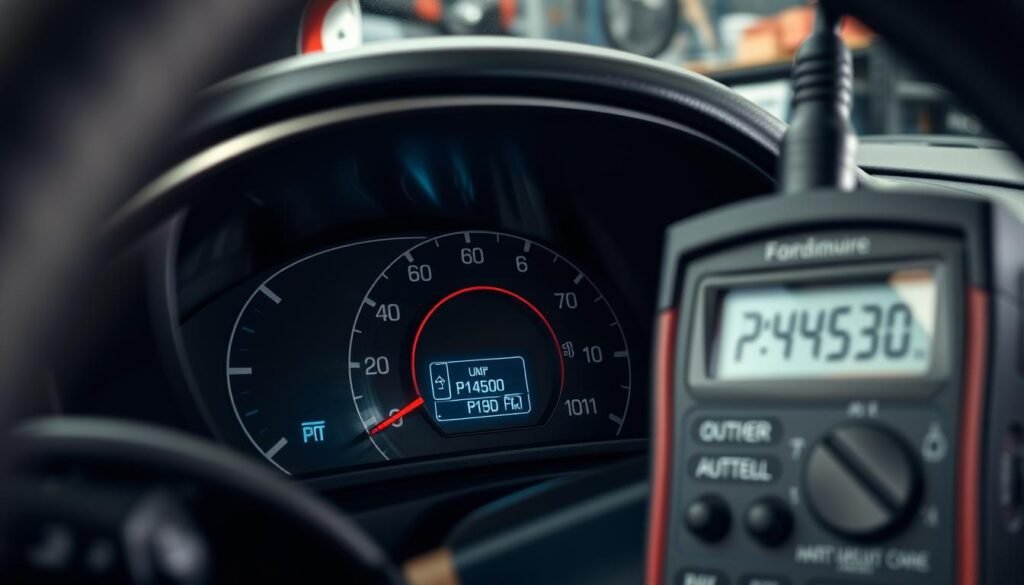
How To Diagnose The Ford Escape P1450 Code?
To figure out the ford escape check engine code p1450, you need to follow a few steps.
Start by using an OBD-II scanner, a crucial tool for reading trouble codes from your car’s computer. It shows any problems related to the code.
Using an OBD-II Scanner
Begin with an OBD-II scanner to address the ford escape p1450 code. Plug the scanner into the car’s diagnostic port and turn the ignition on.
Follow the scanner’s steps to find the codes. Remember to note the P1450 code and any others. This info will help with further diagnostics.
Checking Fuel System Components
Now, inspect the fuel system parts that relate to the P1450 code. Focus on:
- EVAP canister: Look for cracks or damage that may impede function.
- Purge valve: Test for proper operation, ensuring it opens and closes as intended.
- Fuel filler cap: Check for wear, ensuring a snug fit to prevent leaks.
- Vacuum hoses: Inspect for any leaks or splits that can lead to performance issues.
By checking these areas, you can identify any issues tied to the ford escape p1450 code. This helps make sure your vehicle runs smoothly.

| Component | Inspection Checklist | Signs of Failure |
|---|---|---|
| EVAP Canister | Check for cracks and blockage | Check engine light, fuel odor |
| Purge Valve | Test operation and functionality | Weak engine performance, stalling |
| Fuel Filler Cap | Inspect for damage and fit | Fuel leaks, evaporation warnings |
| Vacuum Hoses | Look for splits or leaks | Rough idling, engine misfires |
Code P1450 Ford Escape – Troubleshooting Steps
When dealing with a p1450 code ford escape, start by checking the evaporative emission system carefully.
Look for any wear or damage on the components. This will help you find the root cause of the problem.
Inspecting The Evaporative Emission System
Focus on the canister during your inspection. Check for anything that might block it.
Also, make sure to check the valves and other parts to see if they work right. This detailed inspection is key to figuring out why the p1450 code is showing up.
Assessing Vacuum Hoses and Connections
Then, take a close look at the vacuum hoses and connections. Any leaks can mess with the system’s pressure, which might trigger the p1450 code ford escape.
Search for any cracks or fittings that aren’t tight. This step is vital in fixing the p1450 code on your ford escape and making sure the emission system works well.
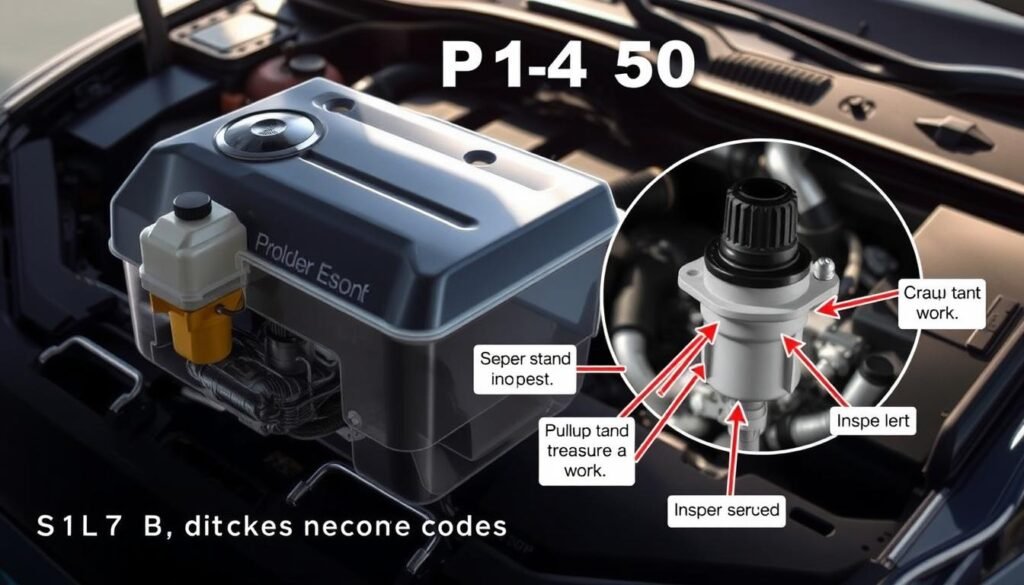
Recommended Fixes For Code P1450
To fix the ford escape p1450 code, you need to do some repairs and checks. Just follow the right steps to fix the problem.
This will make sure your car works well. Here are the tips to tackle the p1450 code on a ford escape.
Replacing The Purge Valve
The P1450 code might be because of a bad purge valve. Here’s how to change it:
- Find the purge valve near the engine.
- Take off the electrical connector and vacuum hoses.
- Swap the old valve with a new one.
- Put back all hoses and the electrical connector.
Clearing Canister Blockages
A clog in the evaporative canister might cause the P1450 code. To fix it:
- Look at the canister for any debris or clogs.
- Blow away obstructions with compressed air.
- Check the hoses for any cracks or damage.
Ensuring Proper Fuel Filler Cap Function
A broken fuel filler cap can also set off the code. To check if it’s working:
- Look at the cap for any cracks and make sure it closes tight.
- If it’s damaged, get a new one that the maker approves of.
- Use an OBD-II scanner to remove the code after changing the cap.
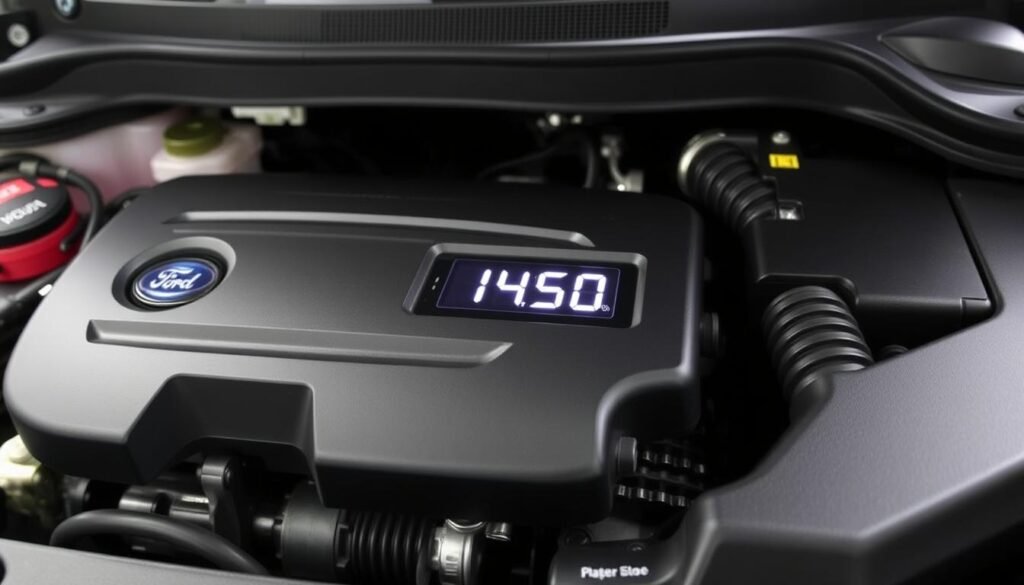
Professional Assistance For Ford Escape P1450 Code
If trying to fix the ford escape diagnostic code p1450 on your own doesn’t work, getting help from experts is smart.
Automotive experts have the right tools and knowledge for a detailed check-up. They are good at fixing complex issues in the EVAP system and make sure everything is up to standard.
Choosing expert help ensures that the job is done correctly and saves you time and money from mistakes.
Their expertise also means they can replace parts effectively, making your car run better. Knowing how much repairs might cost is important too.
Even if paying for a professional look seems costly at first, you often save money in the long run.
Getting professional help means repairs are done properly from the start, giving you fewer worries as a car owner.
Cost Implications of Repairs
Knowing about the ford escape p1450 code solution helps you prepare for repair costs. Prices vary based on the issue.
For simple fixes like changing a bad fuel filler cap, prices start around $100. But, fixing the EVAP canister or purge valve may cost over $500.
The table below gives a clear idea of potential costs for fixing the p1450 code ford escape:
| Repair Type | Estimated Cost Range |
|---|---|
| Fuel Filler Cap Replacement | $100 – $150 |
| Purge Valve Replacement | $150 – $300 |
| EVAP Canister Repair | $250 – $500 |
| Full EVAP System Inspection | $100 – $200 |
Compromise these costs lets you plan your budget wisely. It also means fixing the p1450 code without delay. This approach saves time and helps avoid more problems later.
Preventative Measures For Future Issues
To prevent the code p1450 ford escape, stick to regular maintenance and understand your car’s systems well.
By being proactive, you can dodge unnecessary fixes and ensure your Ford Escape runs smoothly.
Regular Maintenance Tips
- Conduct routine inspections of the evaporative emission system to identify any issues early.
- Check and replace the fuel filler cap periodically to prevent leaks.
- Monitor the purge valve and canister for any signs of wear or blockage.
- Stay on top of oil changes and overall vehicle servicing.
Knowing Your Vehicle’s Systems
Learning how your Ford Escape’s systems work together helps spot problems early.
Knowing about the evaporative system, for example, sheds light on the ford escape check engine code p1450.
This knowledge lets you take care of your vehicle and tackle problems before they grow.
Conclusion
The Ford Escape P1450 code points to a problem with the evaporative emissions system. It’s crucial to deal with it quickly.
Knowing the symptoms and causes helps you solve this issue. You can fix it yourself or get help, saving you time and money.
Understanding the P1450 code is part of keeping your Ford Escape running well. A well-cared-for vehicle is more efficient and safer to drive.
Regular checks can stop future problems, letting you enjoy your drives without worry.
Dealing with the Ford Escape P1450 code improves your car’s performance and your peace of mind. Putting time into maintenance is wise and beneficial over time.
FAQs
Q: What does the P1450 code mean for my Ford Escape?
A: The P1450 code shows there’s an issue in the evaporative emissions system. It often deals with vacuum or pressure problems. Fixing it is key for less pollution and to keep your car running well and legally.
Q: What are the symptoms of the P1450 code in my Ford Escape?
A: You might see the check engine light, feel the engine run roughly, or find the car stalls. There could be trouble when you try to accelerate or refill your gas tank, like spilling or slow filling.
Q: What are the potential causes of the P1450 code?
A: Reasons might be a broken purge valve, plugged EVAP canister, faulty fuel cap, or leaks in the vacuum lines. These issues can mess with the emissions system.
Q: How do I diagnose the P1450 code?
A: Start with an OBD-II scanner to find the codes. Next, look at the fuel components, like the EVAP canister and purge valve, for damage. Check the vacuum hoses for any leaks.
Q: What steps should I take to troubleshoot the P1450 code?
A: First, examine the evaporative emission system for damage. Then, see if there’s a block in the canister and look for any leaks in the hoses. This method helps pinpoint the exact issue.
Q: What fixes are recommended for the P1450 code?
A: Fixes often involve changing the purge valve, clearing the EVAP canister, and checking the fuel cap is okay. These steps will help resolve pressure issues.
Q: When should I seek professional help for the P1450 code?
A: If fixing it yourself is hard or the repairs are complicated, get professional help. Specialists have the tools and skills for proper fixing.
Q: What are the cost implications for repairing the P1450 code?
A: Repair costs vary from 0 to over 0. The price depends on what’s broken. Simple fixes like a new fuel cap are cheaper, but bigger repairs will cost more.
Q: How can I prevent future issues with the P1450 code?
A: To avoid future problems, stick to regular car checks, especially of the emission systems. Knowing how your Ford Escape’s systems work together is also helpful.

